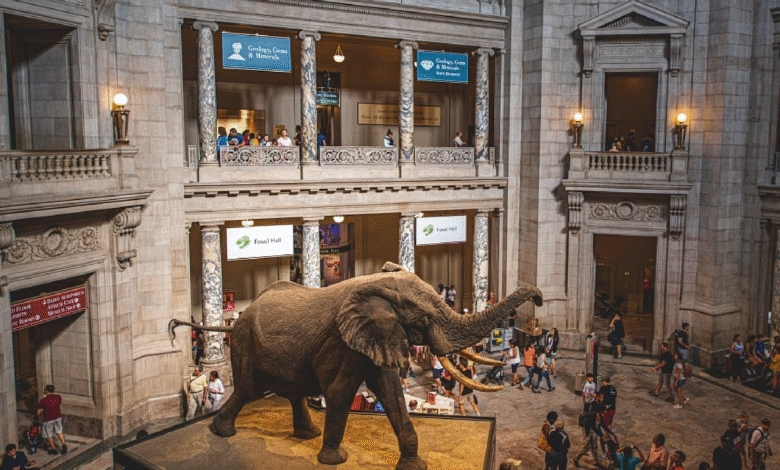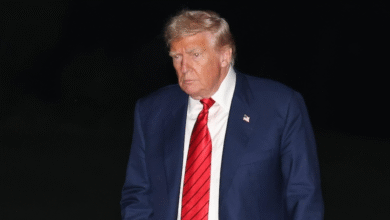Smithsonian Museums Review on American Exceptionalism

The Smithsonian Museums Review takes center stage as the White House embarks on a significant assessment of eight prominent museums to ensure they embody President Donald Trump’s White House Smithsonian directive encouraging the celebration of “American exceptionalism.” This rigorous review focuses on the alignment of Smithsonian exhibits with the spirit of unity and shared history as the nation approaches the 250th anniversary of the United States. Within a tight 30-day timeframe, these cultural institutions are tasked with providing materials related to their displays and educational resources tied to this milestone. Given the ongoing national discourse, this evaluation underscores the critical nature of the museums’ roles in portraying the American narrative, including reflections on diversity and progress. As this situation unfolds, it draws attention to the balance between upholding historical accuracy and catering to contemporary political directives and sentiments surrounding the nation’s identity.
Exploring the landscape of national cultural institutions, the scrutiny over Smithsonian museums has intensified as part of a broader initiative linked to President Trump’s vision for American pride. The review process, which is being propelled by a directive from the White House, focuses on ensuring that exhibits within these museums resonate with themes of unity and national achievements. As they prepare for the significant 250th anniversary of the USA, these renowned museums are expected to analyze and adapt their content in ways that reflect a cohesive American story, free from divisive narratives. This examination is not merely a logistical task; it highlights the intricate dynamics between historical representation and political influence. The Smithsonian’s commitment to maintaining scholarly integrity amidst these pressures remains a pivotal aspect of this ongoing dialogue.
Examining the Smithsonian Museums Review
The recent directive from the White House to review eight prominent Smithsonian museums marks a pivotal moment in the intersection of politics and culture in the United States. This review, aiming to ensure that these cultural institutions align with President Trump’s vision of celebrating ‘American exceptionalism’, raises various questions about the portrayal of history and identity in museum exhibits. The museums included in this review encompass a wealth of American history and culture, including institutions such as the National Museum of American History and the National Museum of African American History and Culture. Such a sweeping governmental directive, especially one calling for a reassessment of educational materials and exhibits, indicates a shift in how history may be interpreted in public narratives as we approach the 250th anniversary of the nation’s founding.
However, the implications of this review may extend beyond mere adjustments of exhibits. The Smithsonian Institution, known for its commitment to a comprehensive representation of American history, could face challenges in maintaining its scholarly independence while also fulfilling administrative requests. Critics argue that the push for alignment with a particular ideological narrative could undermine the integrity of museum collections that aim to reflect the diverse and complex fabric of American society. As other museums await reviews in Phase II, there is widespread speculation about the impact of this initiative on the future direction of American cultural institutions.
The Impact of Political Directives on Museums
Political interventions in museums often spark significant debate about the role these institutions play in society. The Smithsonian’s current position, evolving under the influence of a White House directive, highlights a balancing act where historical narratives might be shaped through the lens of contemporary politics. The mention of issues such as ‘race-centered ideology’ suggests a broader disregard for certain aspects of American history that do not align with the government’s narrative vision. This raises concerns over censorship and the potential for historical inaccuracies, triggering discussions on what constitutes an ‘accurate’ portrayal of the past.
Moreover, the engagement of the Smithsonian with the Trump administration illustrates the complicated dialogue between political authority and cultural expression. Over the years, museums have stood as bastions of learning and inclusivity, but under the current directive, they may need to navigate the challenge of presenting a harmony of perspectives while adhering to governmental expectations. As we celebrate the 250th anniversary of the USA, it will be interesting to observe how these institutions reframe their narratives to align with this push towards American exceptionalism while still honoring the myriad stories that make up the nation’s history.
Controversial Changes within Smithsonian Exhibits
The controversy surrounding recent alterations in Smithsonian exhibits signals a growing tension between institutional integrity and political narratives. Following Trump’s critique of certain content, the Smithsonian’s decision to remove references to his impeachments from the National Museum of American History serves as a case study of the pressures faced by cultural institutions in a politically charged environment. The reinstatement of these references post-backlash might suggest an ongoing struggle to balance governmental expectations with public accountability—a situation that could potentially lead to self-censorship in fear of reprisal.
This, in itself, poses a critical question for future Smithsonian exhibits, particularly as they prepare for the country’s milestone celebrations. With the White House requesting adjustments to align better with its political agenda, museums are now at a crossroads, needing to ensure they still serve as troops of historical truth. The need to restore confidence in shared cultural institutions while adhering to presidential directives creates a challenging landscape that could redefine visitor experiences and learning opportunities. As curators and educators grapple with these shifts, the future representation of American history within these hallowed halls rests under an evolving shadow.
Navigating Cultural Sensitivity in Exhibits
In today’s cultural climate, navigating the delicate topic of historical sensitivity becomes paramount for museums. The directives communicated by the White House challenge these institutions to address how America’s past is portrayed, particularly in relation to themes of race and inclusion. As the Smithsonian prepares for its ongoing reviews, museum professionals are tasked with determining how to present exhibits that reflect diverse narratives while also adhering to requests for a unified interpretation of American exceptionalism.
Such endeavors require not only careful curation but also sensitive communication about the implications of American history and its multifaceted storylines. As American society continues to engage in difficult conversations about race, identity, and history, the Smithsonian and other cultural institutions must adapt to these national dialogues. By emphasizing inclusivity and understanding, museums can strive to portray a narrative that encompasses both the triumphs and struggles of America, engaging audiences in a way that resonates with contemporary discussions surrounding American identity.
Exploring American Exceptionalism in Museums
American exceptionalism cites the unique historical and cultural frameworks that differentiate the United States from other nations. As museums undergo reviews to align with this concept under the current presidential directive, the interpretation of American history is compelled to take on a more patriotic lens. However, the concept itself is often met with scrutiny, raising concerns about the potential erasure of critical historical narratives, particularly those relating to inequality and systemic injustices.
In preparing exhibits for the 250th anniversary, the Smithsonian and similar institutions face the challenge of crafting narratives that honor the diverse experiences of Americans while also responding to political demands. This balance is crucial; while it is essential to celebrate the victories and advancements of the United States, it is equally important to acknowledge the challenges and struggles that have shaped the nation. A thoughtful approach to exceptionalism may provide visitors with a well-rounded understanding of America’s history as a dynamic tapestry of various voices and perspectives.
The Future of Smithsonian Exhibits Under Trump’s Review
As the Smithsonian looks to its future amidst the directives from the Trump administration, museum stakeholders must consider what the forthcoming reviews mean for educational initiatives and public engagement. The emphasis on ‘bringing forth unity, progress, and enduring values’ could invalidate the diverse interpretations of American identity presented in previous exhibits. As the White House continues its evaluation of museum content, the emphasis on a singular narrative may reshape the educational landscapes of these institutions.
Looking ahead, it will be essential for the Smithsonian to reaffirm its commitment to providing comprehensive educational experiences that reflect the entirety of the American experience. This includes tackling difficult yet necessary conversations about race, culture, and history. As many museums globally face similar pressures from political influences, the Smithsonian’s approach could set a precedent for how cultural institutions navigate political directives while maintaining their core values and mission.
Reassessing Educational Materials in Museums
Alongside the scrutiny of exhibits, the assessment of educational materials within the Smithsonian aims to ensure alignment with the White House’s vision. With calls to correct any perceived biases or divisive narratives, the revisions could redefine how educational content is presented in American history museums. This focus on creating materials that emphasize American exceptionalism could be seen as an attempt to unify disparate narratives under a singular theme.
Conversely, this could lead to the dilution of important historical lessons that address America’s complex and often troubled past. Educators and historians within the Smithsonian face a daunting task in re-evaluating educational resources to find common ground between the current administration’s expectations and the institution’s commitment to academic rigor and factual accuracy. As the discourse around educational content evolves, the potential impact on future generations of museum-goers becomes increasingly significant.
The Smithsonian and Political Accountability
Amidst the ongoing review of the Smithsonian museums by the White House, issues of political accountability emerge as critical points of discussion. President Trump’s administration has historically sought to influence the narratives presented by cultural institutions, and the call for a review signifies a willingness to exert control over public statements made by these entities. As the Smithsonian works to fulfill the directive, questions about the integrity of cultural institutions are raised, prompting conversations about their accountability to the public versus their responsibilities to governmental authority.
This climate of scrutiny also invites closer examination of the relationship between museums and historical narratives. The possibility of cultural censorship could pose a threat to the Smithsonian’s credibility as a leading institution committed to scholarship and objectivity. By navigating these complex political waters, museums face the task of preserving their educational mission while ensuring that their collections remain accessible to diverse interpretations of the American narrative.
Anticipating the Outcomes of Smithsonian’s Directive
As the Smithsonian institutions begin to implement changes in response to the White House review, the outcomes may very well influence the broader landscape of American museums. The alterations, guided by a presidential directive focused on ‘American exceptionalism’, could redefine how museums portray the nation’s history, especially as they caution against divisive narratives. As we approach America’s 250th anniversary, the implications of these shifts resonate within and beyond the museum sector.
Going forward, it will be vital to monitor how these changes ripple through other cultural institutions in the U.S. and abroad. Should the Smithsonian’s adjustments lead to significant shifts in narrative presentation and visitor experience, it might set a standard for political interventions in museums nationwide. Observing this evolution will help engage stakeholders in discussions about the future of historical representation and the enduring significance of cultural institutions in articulating an inclusive narrative of America’s diverse history.
Frequently Asked Questions
What is the purpose of the Smithsonian Museums Review related to American exceptionalism?
The Smithsonian Museums Review aims to ensure that the exhibits at various Smithsonian museums align with President Trump’s directive to celebrate ‘American exceptionalism.’ This review will evaluate materials related to the 250th anniversary of the USA and adjust content to reflect a unified narrative of American history.
Which Smithsonian museums are included in the review by the White House for the 250th anniversary?
The White House’s review includes eight key Smithsonian museums such as the National Museum of American History, the National Museum of Natural History, and the National Museum of African American History and Culture, ensuring their exhibits align with American exceptionalism as part of the preparations for the USA’s 250th anniversary.
How has the Smithsonian Institution responded to Trump’s review of museums?
The Smithsonian Institution has expressed its dedication to scholarly excellence and historical accuracy in response to Trump’s review. It acknowledged the letter from the White House and committed to collaborating constructively while ensuring that their exhibits remain factual and informative.
What changes might occur in the Smithsonian exhibits due to the review process?
As part of the review process, the Smithsonian museums might implement content corrections related to narratives seen as divisive or partisan, aligning instead with the White House initiative to showcase ‘American exceptionalism’ and celebrate the country in light of its 250th anniversary.
What was President Trump’s initial concern regarding the Smithsonian museums?
President Trump’s initial concern was that Smithsonian museums had become influenced by a ‘divisive, race-centered ideology.’ His directive seeks to realign the museums’ exhibits to reflect unity and progress, particularly in the context of the upcoming 250th anniversary of the United States.
What are the expected outcomes of the Smithsonian Museums Review led by the White House?
The expected outcomes of the Smithsonian Museums Review include a reevaluation of exhibits to eliminate divisive narratives, an emphasis on shared American values, and a reinforcement of narratives that celebrate American exceptionalism in preparation for the 250th anniversary of the USA.
How long do Smithsonian museums have to comply with the review directives?
The Smithsonian museums have been requested to submit materials related to their exhibits within 30 days following the White House review letter. They are also instructed to begin implementing necessary content changes within 120 days of receiving the request.
How does the Smithsonian justify its exhibit content amid the White House review directive?
The Smithsonian justifies its exhibit content by emphasizing a commitment to scholarly research and accurate historical representation. They have reiterated their focus on factual presentations of history, even as they navigate the changes requested by the White House review.
| Aspect | Details |
|---|---|
| Review Purpose | Ensure alignment with President Trump’s directive to celebrate ‘American exceptionalism’. |
| Museums Involved | 1. National Museum of American History 2. National Museum of Natural History 3. National Museum of African American History and Culture 4. National Museum of the American Indian 5. National Portrait Gallery 6. National Air and Space Museum 7. Smithsonian American Art Museum 8. Hirshhorn Museum and Sculpture Garden |
| Required Actions | Provide relevant materials within 30 days related to exhibits for America’s 250th anniversary. |
| Implementation Timeline | Start content corrections where necessary within 120 days of the letter’s issuance. |
| White House Directive | Remove divisive or partisan narratives and restore confidence in cultural institutions. |
Summary
The Smithsonian Museums Review highlights the impending scrutiny of eight leading museums under the Smithsonian Institution, as directed by the White House to align their narratives with the ideals of American exceptionalism. This review reflects the current political climate and the ongoing debate over how history and culture should be presented in national institutions. In a time when the American identity is under the microscope, it is crucial for museums to balance the celebration of heritage with the commitment to factual scholarship. The challenges that lie ahead could redefine the portrayal of American history in a way that resonates with all citizens.




